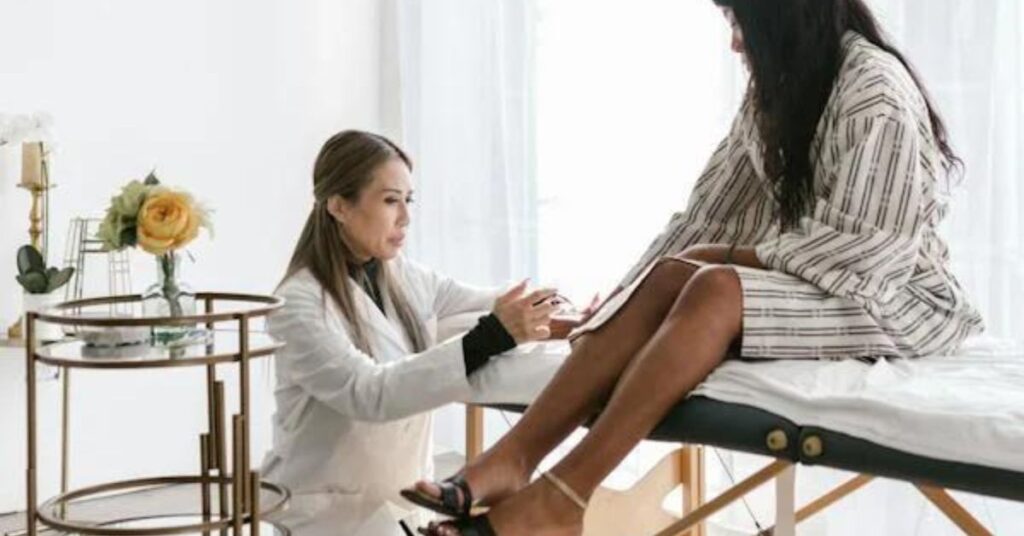Welcome to our guide on what to wear to a massage! Whether you’re a massage enthusiast or it’s your first time experiencing the therapeutic benefits of a massage, one thing remains constant. comfort is key.
Choosing comfortable clothing and preparing properly can help you get the most out of your massage appointment. This guide covers everything you need to know about what to wear and how to prep for your massage.
Table of Contents
Loose, Comfortable Clothing

When it comes to dressing for a massage, the golden rule is to prioritize comfort above all else. Opting for loose-fitting clothing can enhance your overall relaxation experience. Here’s why it matters:
Why It Matters?
- Loose clothing allows for ease of movement and helps you avoid feeling constrained during your massage.
- It promotes airflow, preventing you from overheating while lying on the massage table.
- Comfortable attire sets the tone for relaxation from the moment you step into the massage studio.
What to Wear
- Consider wearing soft, breathable fabrics like cotton or linen.
- Choose clothing that you can easily slip on and off, avoiding items with complicated fastenings or tight elastic bands.
- Examples include loose t-shirts, yoga pants, lightweight joggers, tank tops, shorts, sweatpants, leggings, etc.
What to Avoid
- Steer clear of tight or restrictive clothing that may inhibit your ability to fully relax.
- Skip items with zippers, buttons, or stiff materials that could dig into your skin or cause discomfort during the massage.
- Opting for simple, fuss-free attire ensures that your focus remains on unwinding and enjoying the therapeutic benefits of your massage.
Dress Down to Your Comfort Level
Underwear Preference
- You have the option to leave your underwear on or go bare, depending on what makes you feel most comfortable.
- If you choose to leave your underwear on, opt for a style that won’t dig into your skin or cause discomfort during the massage.
- Alternatively, going bare can provide a sense of freedom and uninhibited relaxation. It’s entirely up to your personal preference.
Communicate with Your Massage Therapist
- Don’t hesitate to communicate your comfort level with your massage therapist before the session begins.
- Your therapist is there to ensure your comfort and well-being throughout the massage experience.
- Feel free to express any concerns or preferences regarding clothing, pressure intensity, or areas of focus.
- Open communication fosters a collaborative and personalized approach to your massage, ensuring that you receive the most beneficial and enjoyable treatment possible.
Further reading: What to wear to a couples massage?
Avoid Strong Scents and Minimize Jewelry and Accessories

Avoid Strong Scents
- Strong perfumes or heavily scented lotions can be overwhelming during a massage, detracting from the relaxation experience.
- Opt for a subtle or natural fragrance, if any, to ensure a more pleasant and tranquil atmosphere.
- Fragrance-free products are often preferred to accommodate clients with sensitivities or allergies.
Minimize Jewelry and Accessories
- Jewelry and accessories can get in the way during a massage, causing discomfort for both you and the therapist.
- Remove any jewelry, including rings, bracelets, necklaces, and earrings, before your massage session.
- Hair accessories, such as clips or headbands, should also be removed to allow for unrestricted movement and comfort.
Focus on Comfort
- The goal of a massage is to promote relaxation and alleviate tension, so it’s important to create a comfortable and soothing environment.
- By avoiding strong scents and minimizing jewelry and accessories, you can enhance your overall comfort and enjoyment of the massage experience.
Prep your body and mind before the massage
Preparing yourself both mentally and physically before your massage can significantly enhance your overall experience.
- Hydrate: Drink plenty of water before your massage to ensure your body is well-hydrated. Hydration helps your muscles and tissues respond more positively to the massage, making it more effective.
- Avoid Heavy Meals: Try to avoid eating a heavy meal immediately before your massage. A full stomach can make you feel uncomfortable while lying down and may interfere with your ability to fully relax. eat a small snack 1-2 hours pre-massage
- Shower: Take a warm shower before your massage to help relax your muscles and remove any oils or lotions from your skin. This can also make you feel more comfortable and refreshed during the session.
- Arrive Early: Arrive at the massage studio or spa a few minutes early to give yourself time to check in, use the restroom, and unwind before your appointment. Rushing can detract from the relaxation experience.
- Practice Deep Breathing: Take a few moments to practice deep breathing or meditation before your massage. This can help calm your mind, reduce anxiety, and prepare you to fully embrace the therapeutic benefits of the massage.
- Set Intentions: Take a moment to set positive intentions for your massage session. Whether it’s to alleviate tension, promote relaxation, or simply take time for self-care, having a clear intention can enhance the overall effectiveness of the massage.
Further reading: What to use for massage oil?
Communicate Goals and Speak Up During the Session

Tell the Therapist about Targeted Areas and Pressure Preferences
- Before the massage begins, inform your therapist of any specific areas of tension, discomfort, or pain that you would like them to address.
- Be clear about your preferences regarding pressure intensity, whether you prefer a gentle, medium, or firm touch.
- Your therapist can tailor the massage techniques to target your individual needs and preferences, ensuring a more beneficial and satisfying experience.
Provide Feedback and Speak Up If Uncomfortable
- Throughout the massage, don’t hesitate to provide feedback to your therapist. If something doesn’t feel quite right or if you’d like adjustments to the pressure or technique, speak up.
- Your comfort and well-being are paramount, so it’s important to communicate any discomfort or concerns that arise during the session.
- Your therapist is there to listen and accommodate your needs, so don’t be afraid to voice your preferences or ask questions.
Trust the Therapist-Client Relationship
- Remember that the massage therapist-client relationship is built on trust and mutual respect. Your therapist is trained to create a safe and supportive environment for you to express your needs and preferences.
- Trust in your therapist’s expertise and experience, but also trust in your instincts. If something doesn’t feel right to you, it’s important to speak up and advocate for your comfort and well-being.
In the final analysis
Getting ready for your massage and dressing comfortably are two important aspects that help ensure that your massage is genuinely relaxing and restorative. Setting the stage for optimal relaxation and wellness involves prioritizing your comfort and being clear with your massage therapist about your objectives and preferences.
Keep in mind that the path to tranquility starts outside the massage parlor. Every step you take to mentally and physically prepare yourself before your massage session improves its effectiveness, from refreshing your body to making pleasant thoughts.
So, slip into your coziest attire, take a deep breath, and surrender yourself to the healing touch of the massage therapist. Whether you’re seeking relief from muscle tension, stress reduction, or simply a moment of tranquility, embracing comfort and communication ensures that you’ll emerge from your massage feeling refreshed, revitalized, and ready to take on the world.
